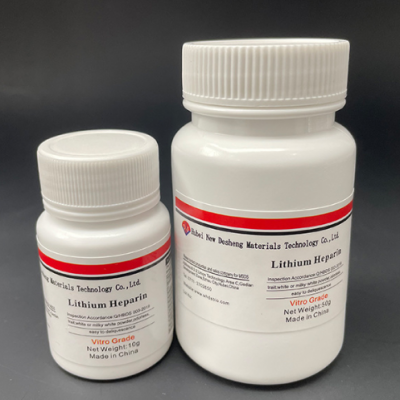Home > Products > Additive for blood collection > Precautions for using anticoagulant EDTA dipotassium
Precautions for using anticoagulant EDTA dipotassium
- 1000 Kilogram / Kilograms per Month
- Shanghai
- T/T L/C
- 5 days
You May Like
-
Manufacturer of blood collection tube additive EDTA tripotassium
-
Spot supply of blood coagulants
-
How to choose high-efficiency coagulant powder and coagulant suspension?
-
Factors affecting the silicification effect of water-soluble silicification agents on blood collection tubes
-
Potassium oxalate as an additive for blood collection tubes
-
Sodium citrate anticoagulant tube for coagulation testing
Product Details
| Brand Name | desheng | Purity | 99 | |
| CAS No. | 25102-12-9 | Classification | High Purity Reagents |
Product Description
Ethylenediaminetetraacetic acid dipotassium, abbreviated as EDTA dipotassium, is a very important anticoagulant in vacuum blood collection tubes. Compared with anticoagulants such as heparin, sodium citrate, and potassium oxalate, it is used more frequently, so understanding some of its usage details is very helpful.
Application of EDTA dipotassium in blood collection vessel types
The anticoagulants added to different types of anticoagulant tubes are naturally different. EDTA dipotassium is usually added to vacuum blood collection tubes for detecting blood routine, usually in the form of purple safety head tubes. In addition, in nucleic acid detection tubes, EDTA dipotassium is generally used as a blood anticoagulant. One reason is that EDTA can chelate calcium ions in the blood, inhibiting the coagulation process; Secondly, EDTA can also chelate magnesium ions, which has an inhibitory effect on nucleases that require the presence of magnesium ions to function, preventing nucleic acids from being degraded by nucleases.
EDTA dipotassium dosage
The dosage of EDTA dipotassium in the blood collection tube is determined based on the amount of blood collected. According to the requirements of Appendix NC of YY0314-2007 standard, the content of EDTA dipotassium or tripotassium in each ml of blood is 1.5-2.2mg, and the median value of 1.8mg/ml is taken when preparing the reagent. It should be noted that the dosage of heparin anticoagulant is 20IU per milliliter of blood, one measured by weight and the other by potency unit, and the two cannot be confused.
Preparation of EDTA dipotassium solution
EDTA dipotassium is a water-soluble salt that can be directly dissolved in water when prepared. However, when mixing EDTA dipotassium or tripotassium anticoagulants with blood samples, there may be a slight dilution effect. In order to control the impact of dilution, the concentration of EDTA solution should not be too low. Usually, 20 microliters of dipotassium solution is added to a blood collection volume of 2mL or 3mL. When it is necessary to increase the amount of dipotassium, the method of increasing the concentration of dipotassium is preferred over increasing the spraying amount. However, the concentration of dipotassium should not be too high. Excessive concentration may lead to a decrease in solubility when the temperature decreases, resulting in the precipitation of EDTA dipotassium crystals. Moreover, high potassium ion concentration poses a risk of hemolysis of blood cells.
The anticoagulant principle of EDTA dipotassium and EDTA tripotassium is the same. After being prepared into a solution, the only difference is the concentration of EDTA acid ions and potassium ions, with slight differences in pH and certain differences in specific detection items. Desheng focuses on the research and production of in vitro diagnostic reagent raw materials, and can provide high-quality EDTA dipotassium, tripotassium or other anticoagulants.
Contact Us

- Hubei New Desheng Material Technology Co., Ltd
- Contact nameDoris Yang Chat Now
Product Categories
| Additive for blood collection | Biological buffer | Chemiluminescence reagent | Chromogenic substrate |
New Products
-
What is the use of the new Trinder's reagent TOOS 82692-93-1?
-
Application Introduction of TOPS Color Reagent (CAS40567-80-4)
-
What applications can the chromogenic substrate ADOS 82692-96-4 be used in?
-
What are the advantages of using ADPS 82611-88-9 as a chromogenic substrate?
-
Application of color reagent ALPS 82611-85-6 in biochemical experiments
-
Preparation and Use of New Trinder's Reagent DAOS 83777-30-4 Solution
-
Advantages of HDAOS 82692-88-4 as a chromogenic substrate in Desheng
-
What is the function of the chromogenic substrate MADB 209518-16-1?
-
What are the advantages of the chromogenic substrate MAOS (CAS82692-97-5)?
-
The role of TODB 127544-88-1 in blood lipid testing kit
-
Desheng can supply high-quality luminol raw materials
-
Which is a good place to buy Luminol Monosodium Salt (20666-12-0)
-
Chemiluminescent reagent isoluminol factory direct sales
-
Luminescence analysis of high-purity acridine ester NSP-DMAE-NHS 194357-64-7
-
Direct chemiluminescence of acridine ester DMAE-NHS 115853-74-2
-
Detailed introduction of luminescent reagent NSP-SA 211106-69-3
-
Precautions for using chemiluminescence reagent acridine salt NSP-SA-NHS 199293-83-9
-
Detailed Introduction to Acridoyl Hydrazide NSP-SA-ADH
-
What are the functions of luminescent reagent acridine ester ME-DMAE-NHS?
-
What factors determine the performance of biological buffer TRIS 77-86-1
-
Storage conditions for Tris HCl buffer 1185-53-1
-
99% of customers choose Bicine buffer manufacturer
-
Application of Biological Buffer CAPS 1135-40-6 in Diagnostic Kit
-
Why choose MOPS buffer produced and developed by Desheng?
Popular Searches
Recommended Products
- Polyquaternium-1 cas 75345-27-6 Polidronium Chloride Anti-Glaucoma Combination Eye Drops Lens Care Solution
- Introduction to MOPSO Sodium 79803-73-9 Biological Buffer
- What are the advantages of Desheng in producing 3- (N-morpholino) propanesulfonate sodium salt (MOPS-NA)?
- 3- (N-morpholine) propanesulfonic acid half sodium salt MOPS half sodium salt
- The importance of BIS-TRIS HCl in electrophoresis, extraction, separation, and purification processes
- Characteristics and Use of TES Chemical Reagent as a Biological Buffer
- 2- (N-morpholine) ethanesulfonic acid monohydrate MES monohydrate
- Exploration of Buffer Performance and Stability of PIPES-K2 108321-27-3
- Biological buffer piperazine-1,4-diethylsulfonic acid monosodium salt PIPES-NA basic information
- Introduction and Application of Biological Buffer BIS Tris Propane 64431-96-5
- Silver chloride manufacturer direct supplier phone number, analytical grade 99.5% chemical formula AgCl
- You can't help but know about the applications of CHAPS buffer
Find Similar Products By Category
- Chemicals > Chemical Reagent
Product Tags:
- Please Enter your Email Address
- Please enter the content for your inquiry.
We will find the most reliable suppliers for you according to your description.
Send Now-
 Doris Yang
Welcome to my shop, I'm glad to serve you. Please feel free to send me any questions you may have.
Doris Yang
Welcome to my shop, I'm glad to serve you. Please feel free to send me any questions you may have.
Your message has exceeded the limit.
- Contact supplier for lowest price
- Customized Request
- Request Sample
- Request Free Catalogs
Your message has exceeded the limit.
-
Purchase Quantity
-
*Sourcing Details
Your inquiry content must be between 10 to 5000 characters.
-
*Email
Please enter Your valid email address.
-
Mobile







